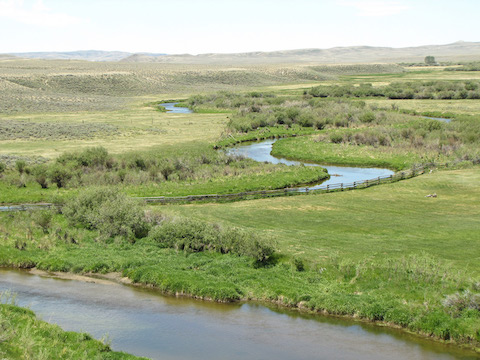Sixth Crossing
Sixth Crossing is a historic site along the Mormon Trail. It is located approximately 40 miles southeast of Lander, Wyoming. Sixth Crossing is so named because it was the sixth time travelers following the well-established Oregon-Mormon-California Trail westward would cross the meandering Sweetwater River. Sixth Crossing was a popular spot to refresh after about 16 miles of traveling with limited water.
Here at Sixth Crossing, the Willie handcart company of converts to The Church of Jesus Christ of Latter-day Saints, encountered the first rescue wagons from George D. Grant’s relief party on October 21, 1856.
Contents
History
The Sweetwater River is a 238-mile tributary of the North Platte River and part of the Mississippi River system that eventually reaches the Gulf of Mexico.
The Sweetwater River provided a route used by fur trappers, mountain men, and fur traders as they went to their annual summertime Rocky Mountain Rendezvous. Their path was cleared and a rough wagon trail was traveled by many others. The water itself was too swift to be traveled on by canoe. But traveling near the river provided water and vegetation for the travelers and their pack animals. The trail also provided an almost direct path from the Platte and North Platte Rivers to the wide South Pass Continental Divide.
The Sweetwater River meandered, requiring the wagon trails to cross the river nine times. The first crossing was near Independence Rock, named by fur traders who had camped there on July 4, 1824.
Travelers to California and Oregon knew that if they reached Independence Rock in early July, they would arrive at their destinations ahead of winter snows. For travelers to Utah on the Mormon Trail, the distance after Independence Rock was shorter—about 330 miles (530 kilometers). They could reach the landmark in late August or early September and still expect to reach the Salt Lake Valley before winter.[1]
Latter-day Saint Migration
The first Mormon Pioneers reached Utah Territory in 1847, and the leadership of the Church encouraged the many converts from the British Island and Europe to immigrate to Utah. Many paid their own expenses, and many traveled with funds provided from the Perpetual Emigration Fund.
Emigrants came by ship from England and arrived in New York or Boston. They traveled by rail to Iowa City, Iowa, and then to Utah by ox and wagon. Later, pioneers were outfitted with the more economical handcarts and supplies. The first three handcart companies departed Iowa City in June and arrived in the Salt Lake Valley by the end of September or early part of October.
The next two handcart companies and two wagon companies started their journey much later than was safe. The Willie handcart company left Iowa City on July 15, 1856. The Martin company followed soon after on July 22; the Hodgetts wagon company left on July 30; the Hunt wagon company left August 4. The Willie company did not pass Independence Rock until October 14. The Martin, Hodgetts, and Hunt companies passed Independence Rock in early November with the help of George D. Grant’s relief party.
On October 19, 1856, a severe snowstorm hit the plains of Wyoming. Despite these harsh conditions, the Willie handcart company continued to push and pull toward their sixth crossing of the frigid Sweetwater River. They were starving, freezing, and completely out of food. Despite supplies and assistance from the relief party, nine of the Willie company died at Sixth Crossing.
Additional rescue wagons had been sent by Brigham Young to bring the pioneers off the plains. The Willie company was brought into Salt Lake by rescuers on November 9. The Martin company arrived in Salt Lake on November 30. The Hodgetts and Hunt companies arrived on December 15.
Sixth Crossing: Mormon Trail Site
Today Latter-day Saints remember the faith and courage of the handcart pioneers and their rescuers. Trek reenactments often occur during the summer months for primarily youth groups to experience the difficulty of pulling handcarts and the dedication of early members of the Church to join the main body of the Church in Utah.
Sixth Crossing is now on private land, but a visitors’ center is maintained by The Church of Jesus Christ of Latter-day Saints and is open to the public.
